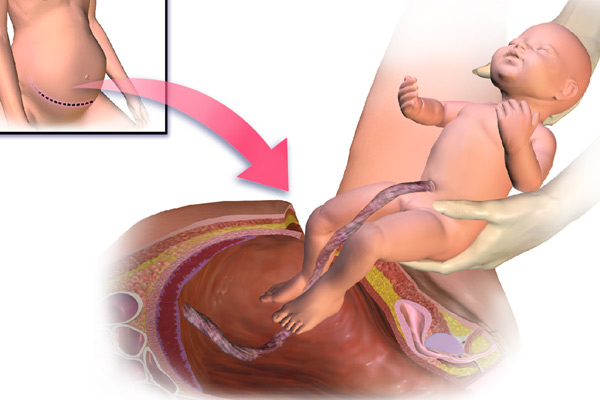C-Section Pregnancy Guide: Who Needs It, Procedure, Complications And Delivery Side Effects

Many expectant moms look forward to beautiful childbirth. The news that she may need to be delivered by cesarean section might feel disappointing. About 30-35 per cent of babies are delivered by C-section - it means, all things being equal, you have about a 1 in 3 chance of having to go that route.
Two things are for sure: Your birth experience will not be as warm and intimate as you may have imagined, and your body will need more time to recover than if you had a vaginal delivery.
Why would you need a C-Section?

Your doctor may schedule it in advance or it may be an emergency decision during labour.
When do you need to have a scheduled C-section take place?
- Multiple pregnancies: The likelihood or the procedure increases with the number of babies you are carrying.
- Placental problems: If the placenta is partly or completely blocking the cervical opening. (Placenta Previa)
- Pregnancy-induced high blood pressure or eclampsia (a very rare progression of pre-eclampsia that affects the central nervous system, causing seizures).
- Breech position: When your baby is either feet first or buttocks first.
Also Read: Is There A Right Biological Age For Women To Get Pregnant? Here's The Answer!

- A previous C-Section: While having a first cesarean raises your risk of subsequent procedures, vaginal birth after C-section or VBAC is frequently successful and often recommended.
- Certain medical conditions: Like heart disease, diabetes, high blood pressure, kidney disease can make vaginal delivery dangerously stressful to your body and birth by C-section a safer option.
- Infection: If you are HIV Positive or have an active genital herpes infection, a scheduled C-section may be necessary because both viruses can be transmitted to your baby during delivery.
- Your baby’s health: A congenital condition might make the journey through the birth canal more dangerous.
- Your age: While being older doesn’t guarantee a cesarean delivery by any means, the odds of having one increase with age.
Recommended Read: Pregnancy Guide: Risks And Benefits Of Summer Pregnancy, What To Eat And How To Stay Healthy
Why do you need an emergency C-section
Continue reading below

- Labour doesn’t start: Your cervix isn’t dilating although you are having contractions for over 24 hours in a first time mother and fewer hours for subsequent deliveries.
- Labour stalls: You might sail right through the early stage of labour only to grind to a halt.
- Fetal distress: If the fetal monitor is picking up signs of your baby in distress.
- A prolapsed umbilical cord: When the umbilical cord slips into the birth canal before baby does.
You may like: Hair Fall During Pregnancy Is Most Common; Here're Effective Ways To Prevent Excess Hair Fall
C-Sections by choice

Since cesarean deliveries are safe and can prevent the pain of labour, some women (particularly those who’ve had a C-Section before) prefer them to vaginal deliveries and actually ask for them in advance. Although experts agree that C-sections shouldn’t be the delivery of choice, at least when there is a choice.
- Are you afraid of the pain of labour? Most women share their fear but electing to have a C-section isn’t the only way to have a delivery without pain. There are many effective pain-relief options available to women undergoing a vaginal birth.
- Have you heard that vaginal birth causes urinary incontinence? Vaginal birth can increase the risk of leaking but pregnancy itself is a culprit and weakens your pelvic muscles. Regular pelvic floor exercises like Kegels, significantly reduces that risk.
- Do you want your delivery to fall on a convenient day? C-section is major abdominal surgery and you will be exposing yourself to the risk that surgery entails.
- Is there another baby in your future? Remember that opting for a C-section now may prevent you from delivering vaginally next time. C-section increases your risk for complications including Placenta Previa, Placenta Acreta and retained placenta in future pregnancies.
What is it like to have a C-section?

Unless there is a special situation, the woman will be awake during the surgery. Before the surgery starts, there are many preparations: An intravenous (IV) line will be put in the woman's arm or hand. The IV will be used to deliver fluids as well as medicines. An anesthesiologist will give an injection into her back to deliver spinal anesthesia which numbs her belly and legs. She will be positioned under the operating light on a firm, narrow bed that is slightly tilted to prevent her from lying flat on her back.
Also Read: 6 Celeb Mommies Who Opted For Prenatal Yoga To Stay Happy And Healthy During Pregnancy
A catheter will be inserted into her urethra to drain urine. The catheter will stay in place for about one day, and will be removed when the woman can walk on her own to the bathroom. Her belly and thighs will be shaved and cleaned with a special soap to reduce infection. Her belly, legs, and chest will be covered with sterile cloths and a curtain will be raised between her head and her lower body.

Machines will check her blood pressure and oxygen levels. Before the surgery starts, staff will count all of the tools (clamps, scissors, etc.) and other supplies and may introduce themselves and double-check the woman's name and the reason for the surgery. These are safety checks to help prevent errors in the operating room.
During and after birth
During the surgery, the woman will have her partner next to her on the same side of the curtain. The anesthesiologist will also be on that side of the curtain. After making sure the tummy is numb, a doctor and a surgical assistant will begin the surgery. The woman may feel tugging and pulling sensations, especially right before the birth of the baby, but should feel absolutely nothing sharp. It usually takes about 15 minutes from when the surgery begins to when the baby is born.

The neonatologist will dry and place the baby on a warming table to do a quick check on the baby’s breathing, colour, and heart rate. Once the baby is stable, the baby maybe wrapped and brought to the woman to cuddle cheek-to-cheek. Some hospitals will place the baby skin-to-skin on the woman’s chest because early skin-to-skin contact afterbirth is healthy for babies and women. After the baby is born, the doctors will deliver the placenta, and stitch the uterus and other muscle and tissue layers. The skin closure is done with stitches or staples.
Also Read: 8 Bollywood Celebrity Mothers Who Opted For C-Section To Deliver Their Celeb Babies
Stitches will dissolve on their own after a couple of weeks. Staples are removed with a special tool either just before the woman goes home from the hospital or at an office visit about 1 week after the birth. After the surgery is done, the woman is moved to a recovery room for an hour or so or directly to the room. The baby is shifted to the room with the mother. This is a good time to have the baby skin-to-skin and begin breastfeeding.

The spinal anaesthesia wears off in 3-4 hours and pain medications are then given by IV. The woman cannot eat or drink at first, but will soon be able to have clear liquids like coconut water or clear soup, than regular food. At this point the IV will be removed and the woman will take pain medication by mouth. Most women stay in the hospital for about 3-4 days after a C-Section.
Complications

While C-Section is extremely safe, very rarely, complications happen. For mothers, these complications may include reactions to medications or anaesthesia used during the procedure, blood loss and infection. Blood clots in the legs, pelvic organs or lungs also occasionally occur. Your bowel or bladder can be injured and require additional surgery to fix. Babies born by C-section are at a higher risk of transient tachypnea (rapid breathing caused by leftover fluid in the lungs).
Recovery

While you may be eager to start caring for your precious newborn, the physical and emotional recovery after a C-section takes longer than it does after a vaginal birth. You can expect to spend around three to four days in the hospital and it will take at least four to six weeks at home before you’ll fall back to normal. In addition to the soreness, you will feel at the incision site, you will be dealing with the same symptoms during your recovery after a C-section, as you would experience in a vaginal delivery. The symptoms include postpartum fatigue, postpartum bleeding or discharge, breast engorgement, postpartum blues.
You may also like: Pregnancy Guide: Difference Between Normal Delivery And Caesarean Section, Benefits And Risks

Keep an eye on your incision: Itching and pulling sensations around the incision as well as numbness are all normal. If you have fever, and feel a lot of pain or the wound gets red or oozy, call your doctor.
Do your Kegels right away: Pregnancy still takes its toll on those pelvic floor muscles. You should, however, avoid having sex. You’ll have to wait a few weeks before your doctor allows workouts. Even when you are lying down, you can speed recovery by boosting your circulation and muscle tone. For starters, regularly flex your feet, stretch your calf muscles, and wiggle your legs around as much as you can. It will help with gas and constipation too.
The good news

- It's happy delivery and medically safe: Although it’s still considered major surgery, it's actually a happy one and usually is very safe. If it is medically necessary, it can be the safest way for your baby to enter the world.
- Baby will have a nice rounded head: Another bonus your baby will be born with a nicely rounded head, rather than the pointed head of a newborn who has made the tight squeeze through the vaginal canal. It prevents pelvic wear-and-tear as an episiotomy that can result in pain.
- It prevents pelvic wear and tear: Sitting will be easier for you than for vaginal deliveries. Another nice benefit is that you will not have any bloodshot eyes and bruises on your face. Finally, studies show that having a C-section doesn’t negatively impact your future fertility.
In the end, the best birth is the one that’s safest. Any delivery that brings a healthy baby into the world and into your arms is a perfect delivery.
NEXT: Dia Mirza, Neha Dhupia And 8 Other Celebs, Who Got Massively Trolled For Announcing Their Pregnancy
advertisement
advertisement
advertisement









